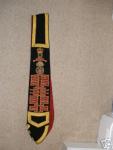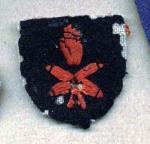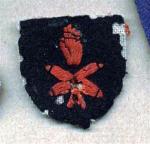-
Posts
1,065 -
Joined
-
Last visited
-
Days Won
1
Content Type
Profiles
Forums
Blogs
Gallery
Events
Store
Everything posted by Graham Stewart
-

Colour Sash
Graham Stewart replied to Graham Stewart's topic in Great Britain: Militaria: Badges, Uniforms & Equipment
Leigh, Thanks for your input on this item, as there is one other point about it that has me doubt it's authenticity and that Colour Sashes were often produced in the facing colour of the regiment. In the case of this sash its dark blue, whereas I almost certain those carrying the Colours of the Royal Northumberland Fusiliers were in the facing colour of "Gosling Green". Graham. -
This may very well get me into trouble here and I'm not sure if this is the right place within the GMIC to discuss this, but on a very well know auction site this item has come up on a number of occassions. It allegedly is a Colour Sash of the 2nd Bn, Royal Northumberland Fusiliers, the problem being that is bares a Queens(St.Edwards) Crown & 'EIIR', so you have to be looking at an item that was into use by the regiment on Princess Elizabeth's assencion to the throne, therefore becoming Queen Elizabeth the 2nd. No problem with that, apart from the fact that the 2nd Battalion, Royal Northumberland Fusiliers was disbanded in Newcastle in 1948 after a formal standing down parade at the Moorish Castle, Gibraltar on the 5th July of the same year, which in my own maths mind was some five years ahead of when Queen Elizabeth II was proclaimed our monarch. I did actually point this out to the seller who said that "I must be mistaken", as he was serving in the 2nd Battalion,R.N.F., when they "became the 1st Bn, Royal Regt of Fusiliers in 1968 and they were formed with three battalions". Again something of a phallacy, as it was the 1st Bn,R.N.F. that formed the 1st Bn, R.R.F. on St.Georges Day 1968 and there were infact 'four' new battalions created that day as the 1st Bn, R.Warwickshire Regt was converted to Fusiliers to become the 4th Bn, R.R.F. under the new 'large regiment' scheme. Now as the starting price has now been doubled by the owner, to a three figue sum - I would advise potential bidders to approach this item with some caution. I add the following from the 2nd Battalion C/O;- 2nd Bn, Fifth Fusiliers Special Order by Lt-Col B.J.Leech, D.S.O. Gibraltar - Monday 5th July 1948. "The Regiment raised in 1674, has been in continuous existence since that date. During this period of 274 years the Regiment has been composed of a number of Bn's, as occassion demanded, the greatest number being fifty-two battalions in the 1914-18 War, a record for the British Army; but for a great many years the Regiment in common with other Regiments of the Infantry of the Line was a single battalion Regiment." "The 2nd Bn, was first raised in 1799 and disbanded in 1802, raised again in 1804 for the Peninsular War and disbanded after the Treaty of Paris in 1816. The 2nd Bn was raised a third time in 1857 at Newcastle-upon-Tyne for service in the Indian Mutiny, rising to a strength of 1,000 in two months, and this last period of 91years has been broken until now." "With the introduction of the Cardwell Reforms in 1882 all Regiments of the Infantry of the Line were placed on an establishment of two regular Bn's, and this year 1948 all Regiments are required to revert to the single battalion establishment by Army Council Instruction, which His Majesty the King has approved with great regret. Thus once again the 2nd Bn is disbanding." "The disbanding of the Bn will take place at Newcastle-upon-Tyne when the Representative Cadre assemble there and the Colours will be laid up with the old Stands of Colours in the Cathedral. The Cadre will be commanded by Major R.M.Pratt." "The Representative Cadre will embark today under the command of Lt J.T.Watson in the Troopship "Cheshire" and thus the 2nd Bn, Fifth Fusiliers leaves the Fortress and Garrison of Gibraltar to return to England, leaving the 1st Bn, Fifth Fusiliers in its place." (B.J.Leech), Lieut - Col, Commanding 2nd Bn, The Fifth Fusiliers.
-
Buttons just didn't change overnight from numbered to regimental, they evolved over a period of time, because in 1855 a new pattern tunic was adopted in which the new pattern brass button was also introduced which included both regimental number and in many cases devices which were historically connected to the regiment concerned. Previous to this buttons for other ranks had been of plain backed pewter, while officers were either of gilt or silver metal. The face was usually die-stamped with a non-regimental design, but in 1767 regulations were introduced which ordered that the number of each regiment of Foot and Dragoons should be placed upon buttons. During the same year regiments of Dragoon Guards were ordered to carry the initial of their regiment upon their buttons. The buttons remained flat, but convex faced buttons were eventually taken into wear, which by 1820-1830 were replaced by convex closed back buttons. By 1881 all buttons for regiments with the exception of the Household Cavalry, Cavalry of the Line, Royal Regt of Artillery, Corps of Royal Engineers, Foot Guards, Rifles, Departments and Corps, had taken into wear the universal pattern button, which bore the "Royal Arms" only. In 1924 buttons of a purely regimental pattern with no numbers were introduced for were by all ranks in gilt for officers and brass for other ranks. While plain buttons were adopted by the following Hussar Regiments;- 3rd Kings Own 4th Queens Own Hussars 7th Queens Own Hussars 13th Hussars 18th Royal Hussars 13/18th Royal Hussars(QMO). This only covers the Regular Army and not the Militia or Rifle Volunteers. Graham.
-

Help with document
Graham Stewart replied to RedMaestro's topic in Great Britain: Orders, Gallantry, Campaign Medals
You'll actually find him in two medal roll books one being the 1914/15 Star Roll and the other being the BWM & Victory Rolls hence the indication of page numbers. In the Rolls will be his actual rank at the date the Star was awarded and similar will be found in the BWM & Victory Roll. During the Great War the unit was actually known as the Hong Kong Singapore Battalion, R.G.A. and had consisted of 5 Company's rather than batteries up to 1913, not all of whom were based in Hong Kong. No.5 Coy for instance had origianlly been No.1 Coy, Ceylon-Mauritius Bn, R.G.A. who didn't join the Bn until April 1908 and was then designated No.5 Coy. In 1913 No.1 Coy was redesiganted as 1st Mountain Bty. Graham. -
The actual title of the unit in question is actually the "Singapore Volunteer Artillery Corps", which was formed in 1888. In 1928 all of the volunteer formations within the Straits Settlement were re-organised as the the "Straits Settlement Volunteer Force" and among them was the "Singapore Royal Artillery(Volunteers)". However I'm unable to find any photographic references regarding badges to either of these two units and trying to blow up the image within the post failed miserably. Graham.
-

victory medal WWI
Graham Stewart replied to martty's topic in Great Britain: Orders, Gallantry, Campaign Medals
MIC = Medal Index Card - can be accessed from our National Archive's website. GSM = General Service Medal Graham. -
Brian, What we need is a scanned shot and then a blow up and in particularly the head and shoulders as luckily for you he's wearing collar badges. At the moment all that I can tell you is that his uniform and riding whip gives me the impression he has something to do with horses, so he could be cavalry or army service corps, but definatley not artillery, engineers or infantry. Graham.
-

Unit ID from helmet flash
Graham Stewart replied to Tony's topic in Great Britain: Militaria: Badges, Uniforms & Equipment
Tony, Sorry that I overlooked this little beauty, but I've downloaded it to my computer and then blown it up but it goes fuzzy. I have seen a very similar flash just recently in a photo and I'm sure it said 'Signals' or some thing like that. However do not despair get hold of a x10 magnifyer and have look at it then and hopefully it'll come up OK, revealing the identity of the unit. The photo itself looks to be India and from the background was taken at one of our old hill stations, which are mostly located in modern day Pakistan. Graham. -
TI, Could be a one off and if so a rarity even if printed in 1947. The MOD Library at Old Scotland Yard used to have runs of regimental journals, but I'm not sure if their collection was cleared out during a re-org when they proposed modernisation. Infact I'm not a 100% certain if it's still open as there was talk of closing it down altogether as part of "Defence Cuts" in late 80's early 90's. Seemingly it was too expensive to have librarians on site and only nutcases like myself tended to use it's facilities and then I had to write my requests to them. Graham.
-

Cambridgeshire Regiment
Graham Stewart replied to Barney's topic in Great Britain: Militaria: Badges, Uniforms & Equipment
The Suffolk & Cambridgeshire Regiment(Territorial) was formed on the 1st April 1961 as an amalgamation of two territorial battalions - the Suffolk Regt(T.A.) & 1st Bn, Cambridgeshire Regt(T.A.). It consisted of the following four Companies;- 'A'(Suffolk & Norfolk Yeomanry)Coy. 'B'(Suffolk & Cambridgeshire Regt)Coy. 'C'(Suffolk & Cambridgeshire Regt)Coy. 'D'(Suffolk & Norfolk Yeomanry)Coy. Still unsure of the units locations, but they would have been published in ACI's and I do remember Soldier Magazine bringing out a Special Supplement of those amalgamations and locations. For an update on all old & new units this is probably one of the best sites for British Army organisation, which I recommend;- http://www.regiments.org/regiments/uk/volm...f-ea/cb1908.htm Also in hardback "The Lineage Book of British Land Forces 1660 - 1978, Vols I(Infantry) & II(Royal Artillery)" by J.B.M. Frederick. Although only taking us up to 1978 the team on the above website are in the process of updating Fredericks work, which hopefully will be republished updated. However Frederick also did all of the Corps and this team were also given access to his notes regarding the Corps, but it's not clear what they hope to do with them. Graham. -
Plus all the patches were worn in pairs, and considering the illustrations were taken from either samples or photographs, then anyone who is offered a patch with a right hand is being offered a duff one. In one section the list of units were missed out and they should read;- 5 - 11th R.I.Rifles 6 - 12th R.I.R. 7 - 13th R.I.R. 8 - 9th R.I.F. 9 - 11/13th R.I.R. 10 - 1st R.I.F. 11 - 108th M.G. Coy. 12 - 108th L.T.M.B. 13 - 122nd Fld Coy, R.E. 14 - 108th Fld Amb, R.A.M.C. 15 - 153rd Bde, R.F.A. 16 - 'C' Bty, 173rd Bde, R.F.A. 17 - 223rd Div Employment Coy. Graham.
-
Well after a good two hour search in the loft I can announce that Laurence is correct and it is 'X'/36 Medium Trench Mortar Battery, R.A. and not associated with the MGC. However the colours are red over black and not red over blue which is always associated with artillery units. What clinched it was an article in the Military Illustrated from August 1991 by Michael Chappell entitled "Irish Divisions in the Great War" and as part of the article he did a superb double page spread of some of his artwork relating to 36th Div, which included a mass of battle patches belonging to the Division. Graham.
-
Well here is the battle patch of 'A' Coy,36th Bn,Machine Gun Corps which belongs to my mate and was formerly owned by 12252 CSM Wiliam Carpenter, D.C.M., who had been posted to 107th Bde Machine Gun Company, M.G.C., 36th(Ulster)Division in 1918. As you can see, I was mistaken about them being the same although both colour & shape are similar and the above is a later 1918 badge. On reflection I still think that the badge illustrated in this post is one of the M.G.Company badges of the 36th Div, prior to the formation of 36th Bn,M.G.C. and that the 'X' isn't a numeral but stylised crossed Vickers machine guns. Graham.
-
PS Almost forgot I think the battle patch is actually 36th Bn, MGC. An MGC researcher friend of mine was given a Pay Book with a patch from a family. The 'X' under closer scrutiny is I believe crossed Vickers Machine Guns and not numerals 'XI'. The use of 'X' in battle patches was quite common among MGC units. I'll try and persuade him to scan his patch which is in very good condition.
-
I'm a member both here and the GWF and have to say that I enjoy both Forums, although as Ed has pointed out they all come with weaknesses and strengths. The GWF does tend to be more for family/historical researchers both amateur and the more serious, rather than collectors and can seem to be more biased towards the European side of the conflict, which was only natural I suppose. However I believe there are other allied WWI Forums which specialise on their home Nation, such as the "C.E.F. Study Group", and their members also tend to drift to the GWF occassionally, although I'm not 100% certain if Australia and New Zealand also have a similar WWI Forum. Ed, While the GWF may not be able to cater fully for your Indian troop interests, I'm also a member of the Military Historical Society, which does have strong leanings towards that sort of research area and occassionally organise trips to our old colonial haunts. Perhaps contact with them may help you out? On another note for British & Indian Divisions serving in those area have you got Beckes "Order of Battle" and also Perry's two later additions which covered Empire troops, as the Indian one is excellent. I'm also in contact with a young Pakistani Doctor who has a great interest in our military fairs in India and especially our old hill stations and is I believe a member of a group trying to save them from destruction. Recently I supplied him with a load of pre-WWI photo's from the regimental journals of the Northumberland Fusiliers, and ironically the photgrapher was the great grandfather of his friend.
-

Cambridgeshire Regiment
Graham Stewart replied to Barney's topic in Great Britain: Militaria: Badges, Uniforms & Equipment
Alan, Being placed in "suspeneded animation", means that the unit would continue in name only through a H.Q. Cadre purely for administration purposes only and neither the 1st or 2nd Battalions were reformed. Placing units into suspended animation, especially after capture, was a common feature of the British Army's Order of Battle during the last war. Contracts for the manufacture of the badges will have been drawn up before the debacle at Singapore, but the manufacture of them doesn't indicate that the units were still in service, although it was perhaps hoped that they would reform in the UK. Graham.












